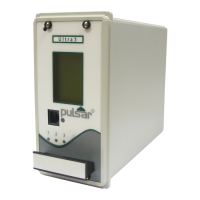PULSAR MEASUREMENT
95
V-Notch Angle Weir (Non-BS 3680) Calculations
Absolute
If the flow calculation is to be absolute P702 = 1 the flow will be calculated
using the formula: q = C
e
8/15 tan (theta/2)(2gn)
0.5
(h = kh)
2.5
Where: q = flowrate
C
e
= discharge coefficient calculated by FlowCERT (P723)
theta = V-notch angle
gn = gravitational acceleration
h = head
kh = compensated head
Ratiometric
If the flow calculation is to be ratiometric P702 = 2 the flow will be
calculated using the formula: q= q
cal
(h+kh/h
cal
+kh)
2.5
Where: q = flowrate
q
cal
= flowrate at maximum head P705
h = head
kh = compensated head
Universal Calculations (P700=6)
Point of Measurement
The transducer must be above the maximum head P704 by at least the
near blanking distance P107.
For all Universal calculation applications, the point at which the head is
measured should be chosen such that the surface of the liquid is not
affected by turbulence.
Absolute
If the flow calculation is to be absolute P702 = 1 the flow will be calculated
using the formula: q = q(h)
Where: q = flowrate
q(h) = flowrate for head
The desired number of Breakpoints, (P730 - P793) are to be entered in pairs
in values of head and corresponding flow. (Minimum of 2 pairs of
Breakpoints is required).

